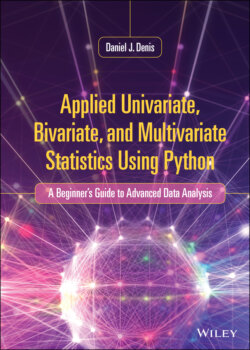Читать книгу Applied Univariate, Bivariate, and Multivariate Statistics Using Python - Daniel J. Denis - Страница 12
Mathematical vs. “Conceptual” Understanding
ОглавлениеOne important aspect of learning and understanding any craft is to know where and why making distinctions is important, and on the opposite end of the spectrum, where divisions simply blur what is really there. One area where this is especially true is in learning, or at least “using,” a technical discipline such as mathematics and statistics to better understand another subject. Many instructors of applied statistics strive to teach statistics at a “conceptual” level, which, to them at least, means making the discipline less “mathematical.” This is done presumably to attract students who may otherwise be fearful of mathematics with all of its formulas and symbolism. However, this distinction, I argue, does more harm than good, and completely misses the point. The truth of the matter is that mathematics are concepts. Statistics are likewise concepts. Attempting to draw a distinction between two things that are the same does little good and only provides more confusion for the student.
A linear function, for example, is a concept, just as a standard error is a concept. That they are symbolized does not take away the fact that there is a softer, more malleable “idea” underneath them, to which the symbolic definition has merely attempted to define. The sooner the student of applied statistics recognizes this, the sooner he or she will stop psychologically associating mathematics with “mathematics,” and instead associate with it what it really is, a form of conceptual development and refinement of intellectual ideas. The mathematics is usually in many cases the “packaged form” of that conceptual development. Computing a t-test, for instance, is not mathematics. It is arithmetic. Understanding what occurs in the t-test as the mean difference in the numerator goes toward zero (for example) is not “conceptual understanding.” Rather, it is mathematics, and the fact that the concepts of mathematics can be unpacked into a more verbal or descriptive discussion only serves to delineate the concept that already exists underneath the description. Many instructors of applied statistics are not aware of this and continually foster the idea to students that mathematics is somehow separate from the conceptual development they are trying to impart onto their students. Instructors who teach statistics as a series of recipesand formulas without any conceptual development at all do a serious (almost “malpractice”) disservice to their students. Once students begin to appreciate that mathematics and statistics is, in a strong sense, a branch of philosophy “rigorized,” replete with premises, justifications, and proofs and other analytical arguments, they begin to see it less as “mathematics” and adopt a deeper understanding of what they are engaging in. The student should always be critical of the a priori associations they have made to any subject or discipline. The student who “dislikes” mathematics is quite arrogant to think they understand the object enough to know they dislike it. It is a form of discrimination. Critical reflection and rebuilding of knowledge (i.e. or at least what one assumes to already be true) is always a productive endeavor. It’s all “concepts,” and mathematics and statistics have done a great job at rigorizing and symbolizing tools for the purpose of communication. Otherwise, “probability,” for instance, remains an elusive concept and the phrase “the result is probably not due to chance” is not measurable. Mathematics and statistics give us a way to measure those ideas, those concepts. As Fisher again once told us, you may not be able to avoid chance and uncertainty, but if you can measure and quantify it, you are on to something. However, measuring uncertainty in a scientific (as opposed to an abstract) context can be exceedingly difficult.
